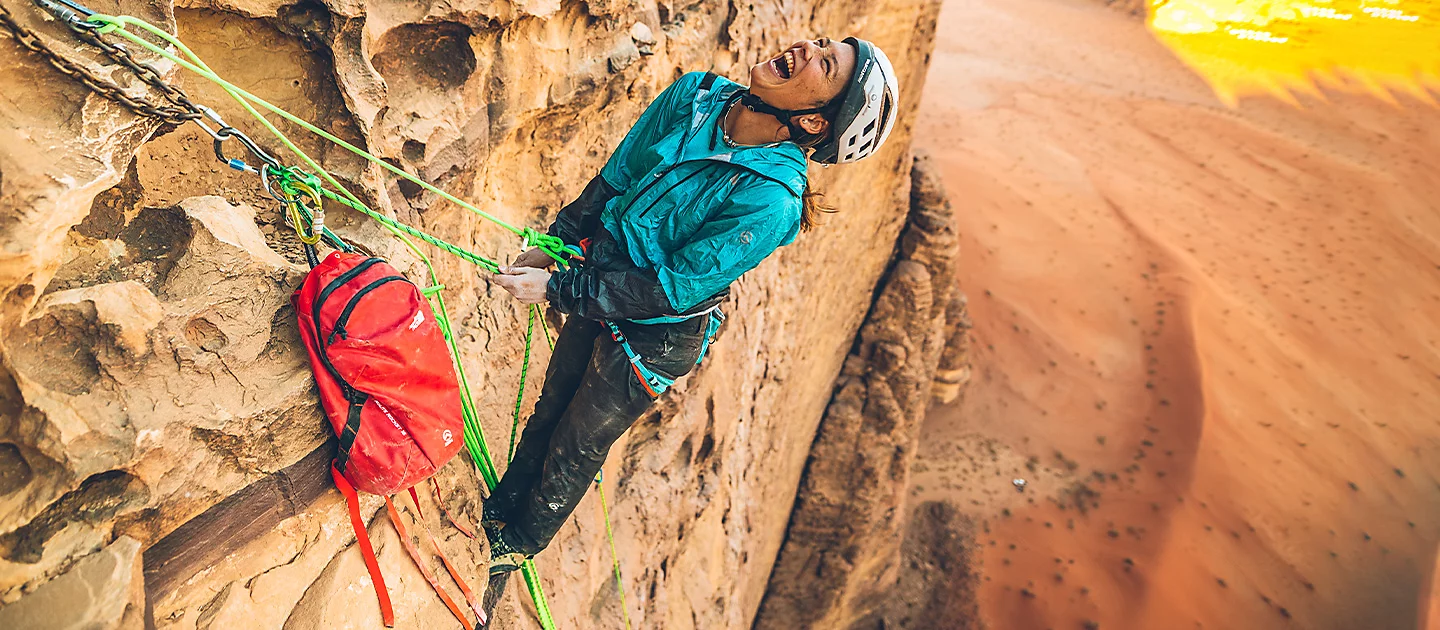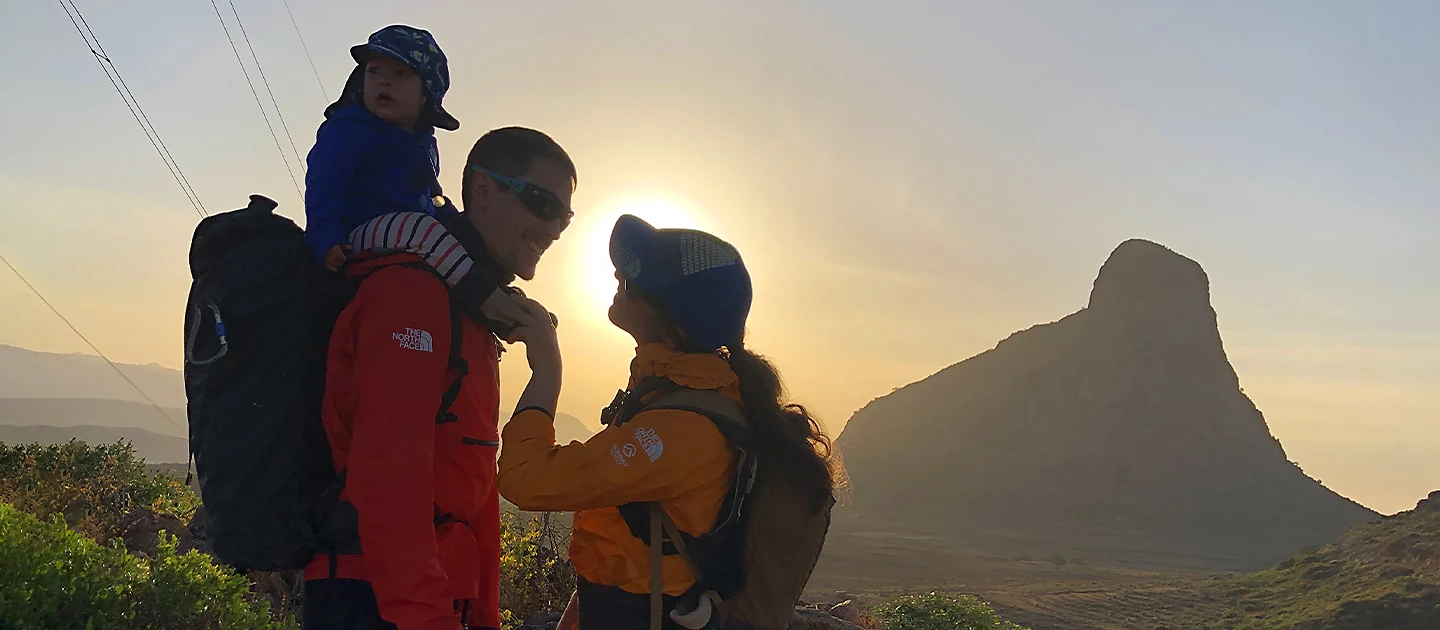Adım Adım
Are risk takers born or made? It’s the classic nature/nurture question. For example, did climbers, James Pearson and Caroline Ciavaldini, become climbers because they have some kind of innate predisposition which makes them better at handling fear and risk? Or does climbing and a lifetime spent adventuring help you become better at handling fear and risk?
LOW RISK. HIGH PRESSURE
Though both climbers, their backgrounds couldn’t be more different. Caroline grew up on the tropical paradise island of Réunion. Famed for its lush vegetation, holiday-brochure beaches and first-rate scuba diving, it’s not the first place that springs to mind as producing world-class competitive sport climbers. It comes as a bit of a surprise that climbing is the island’s fourth most popular sport. But the approach is specific. Students climb in school. They are trained for competition. Risks are low. Structure is high.

HIGH RISK. BIG THRILLS
James, on the other hand, grew up in the UK close to one of England’s best climbing areas, the Peak District. As a child he was curious, trying to climb things around him virtually as soon as he learned to walk. He ‘discovered’ rock climbing through some friends at senior school and was instantly hooked. But he didn’t climb in a gym. He wasn’t armed with the latest gear. He had no inclination to ‘train’. In fact, sport routes were few and far between in the UK at the time and he cut his climbing teeth on gritty trad routes, where risks were often incredibly high.
‘I had no ambition to deal with risk like trad climbing, going on expeditions, first ascents, multi-pitch altitude and all that,’ says Caroline. ‘I was actually against the concept of danger. But James is all about danger and risk management.’


MAKING SENSE OF IT ALL
In their own words, as a couple they ‘don’t make sense’. But together, as their worlds met, their backgrounds and approaches to risk have found a happy medium.
‘We’re like two extremes pulling on the same rope and we find balance somewhere in the middle. Caroline is much more sport-science based. She was of the mindset that her body is a machine, that if you make it do these exercises it will respond in a certain way,’ says James. ‘I was a risk-taking technical climber and I used to steer away from routes that were more just about holding on and fitness rather than technical risk taking. When I met Caro, I realised how important training can be. I was able to do all these things I’d dreamed about before because now I was fit. I realised how important the physical side is. When I met Caro, she had no idea about climbing slabs or moving dynamically, as they’re not needed in competitive climbing. We bring completely different elements to each other and I feel we’re much better as a couple than we are singularly.’
Skills and strengths aside, one of the biggest changes was in risk taking. Caroline was a self-confessed risk-averse climber. She didn’t see the point in taking risks. In fact, she thought risk taking was ‘stupid’. She’d grown up in family where dying of old age was the goal. ‘No one wanted to take any risks that threatened their lives,’ she says. But she knew she wouldn’t always be able to compete in climbing. Like all high-stress competitive sports, they aren’t forever. The body – and mind – can’t handle forever. To her surprise, her transition into trad climbing came naturally, using tools from her competitive climbing toolbox.

‘As a competition climber you have to deal with fear, but it’s different. It’s the fear of failing. But I used these tools of fear management when I was trad climbing to help me deal with the fear of falling.’
STEP BY STEP
Like climbing a tricky crack, with a few falls and missteps, placing protection to secure the climb, over time Caroline built up a greater tolerance to fear. Her approach to risk changed.
‘One of the first times I remember changing my thinking was on a trip to Morocco. As a comp climber I wasn’t used to tricky paths, so I was stepping cautiously from rock to rock. James was just running. It wasn’t dangerous, but you could twist your ankle or knee. Then I thought OK, this isn’t too bad I can accelerate a little bit. And it was fine. This was the beginning of my decision to accept more risk than I would have done before.’

25-year-old Caroline would hardly recognise 35-year-old Caroline. Over the past decade she’s pushed herself to try increasingly challenging and risky routes. She’s now climbed E9 trad routes, 8c+ sport routes, long alpine multi-pitches and on-sighted 8b. Getting there was a process and she is keen to point out it’s about managing risk, not just diving into risk headfirst.
1 + 1 = 3
James, on the other hand, was bold from the start. He’s always managed risk, but his margin of error was pretty sizeable. Though he’s not gone in the reverse direction, he is more mindful of the risks he takes. This is partly down to Caroline, who has shown him that risks can’t be taken blindly. Fear is present for a reason. But perhaps the biggest influence on his actions has been his son, Arthur.

‘I do everything I can to manage risk and Arthur has become another aspect of this. But this doesn’t mean I’m going to stop taking risks altogether. It’s part of who we are,’ says James.
Though Arthur has already travelled to climbing crags from France to Ethiopia, right now, at one and a half, he’s like most other children. He likes playing. He’s curious. He cries. He doesn’t like going to bed. But his parents aren’t like most other parents. Caroline and James take risks. Their tolerance of fear is high. And, according to Caroline, their approach to climbing hasn’t really changed that much since having Arthur. But it’s perhaps this kind of approach that we need more of. We need to be allowed to make mistakes, so long as we learn from them. We need to discover things first-hand to really understand the consequences. We need to experience lows to fully embrace the highs.

‘When I was growing up, I wasn’t ready to take risks that threatened my life. I never realised that you could miss out on things by behaving like that,’ says Caroline. ‘We don’t want to stop taking these risks because we think they’re what makes life 100% life. A little bit more spice and excitement are worth it even if the chances of dying are greater. Of course you don’t want your kid to die early, but you want him to be the happiest he can be. We want him to have a full choice in terms of risk taking then he can choose to take less risks. It won’t be us stopping him.’
THE CHICKEN OR THE EGG?
Although James had a higher tolerance to risk than Caroline, perhaps this is because of his upbringing rather than some innate ability. Perhaps it was his earlier exposure to risk. Perhaps it was an attitude his parents shared that Caroline’s didn’t. Conversely, maybe Caroline’s controlled climbing environment fostered risk aversion. So how will all this play out with Arthur? Will the fact that his parents are so adept at dealing with fear and skilled at managing risk equip him with the same tools? Or will some other outside factor have a roll to play, pushing him in another direction?


‘Terrible things can happen at any time, but you can’t go through life focusing on the 1% of bad things that might happen. You’d never really live,’ says James. ‘The test will be if and when Arthur comes to me and tells me about something that’s really risky. What will I say? Will I be supportive? That’s just something I’ll have to wait and see about.’
